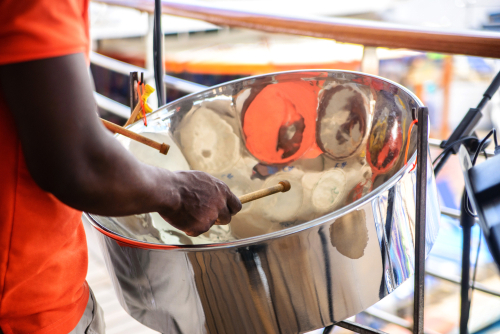21 Mar Where to buy a steel drum: There are plenty of choices!
If you have a love for the steel drum, known traditionally as steelpan, and are ready to make that exciting purchase, you may feel a little overwhelmed with your options. But deciding where to buy a steel drum doesn’t have to be complicated. Should you buy a secondhand steel drum? Should you purchase from a large company or small craftsman?
Panyard’s steel drums are available on our website, and our Jumbie Jams are available on our website, as well as on Amazon and through independent music outlets.

Where to buy full size pans
Our full size steel drums, traditionally known as steelpan, are handcrafted at our facility in Akron, Ohio.
There are four basic steelpan percussion instruments.
- Lead pan C: Our lead pan is a single drum, and is regularly used by soloists.
- Double second: The double second uses two drums, which carry the notes on a whole-tone scale.
- Cello steel drum: The cello steelpan features three drums!
- Bass: Bass steel drums or bass steelpan features six entire steel drums.
Here at Panyard, we also sell traditional “pan round de neck” drums, as well as Tamboo Bamboos, T’ings, and, of course, Jumbies.
Many music stores carry our Jumbies, and some carry a wide range of steelpans. In many cases, stores don’t have steel drums in stock, and you’ll have to preorder them. Many pannists seek out custom steel drum makers, a process that can take a very long time!
Handmade steel drums for sale
Creating steelpan is a form of art, and our artisans here at Panyard spend many hours building and perfecting the instruments. Check out the detailed process in the video below that goes into building our pans!
If you have a love for pan, you’re part of a vibrant, creative community. For inspiration, head over to the Panyard and check out a few people playing our steelpan!
Our handmade steel drums are used in schools, professionally, and just for fun. To start shopping now, visit our website!
The most important thing to look for in a steelpan is to make sure it’s properly tuned. Make sure you purchase a steel drum stand as well as a good pair of mallets or two!
Bonus: How did the steel drum originate?
The steelpan instrument originated in Trinidad. It is part of a storied history of music making, along with other Trinidadian instruments, representing hope and resilience.
In the late 1800s, Carnival was a procession in which groups of people would march through the streets celebrating as they drummed. The use of drums in street parades was outlawed in 1883, since the British feared that the passing of secret messages by means of drumming might become the impetus for social unity and revolt.
Many drum players, deprived of their drums, abandoned drumming altogether, favoring more European, melodic forms of music. However, rhythm being the most important element of African-based music, many drummers simply replaced their drums with sticks, especially with bamboo sticks which could be tuned. These sticks were called Tamboo Bamboo, which, when pounded against the ground, produced distinctive rhythms. In this form, the British repression helped develop the use of drumming sticks in the islands of the Caribbean.
It wasn’t until the beginning of the 20th century that drums and tamboo bamboos were again allowed, with restrictions, during Carnival time. The elaborate processions of Carnival required elaborate rhythms, and drummers started perfecting their instruments to produce a more varied tonal range.
This led to the creation of the Steelpan. Incredibly, the first “pan” used in Trinidad was an empty biscuit container. The people of Trinidad discovered that you could hammer out a tin, resulting in different notes that could be played. Winston “Spree” Simon, in the 1930s at the age of 14, is considered the inventor of the tuned tins.
By the 1930s, the tuned tins became a significant part of the country’s Carnival festivals. The builders using biscuit tins then evolved into utilizing oil drums to make pans, partly due to the war — oil barrels were in high supply. By 1941 many steelbands playing in Trinidad became popular among U.S. soldiers based on the naval bases on the island.
By the late 1950s, it was a mainstay of the culture, and the love of the steel drum spread to other countries. Today the Steelpan is as popular as ever with it’s spirited “sweet sounds of pan” filling hearts globally.

Sorry, the comment form is closed at this time.